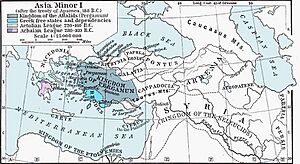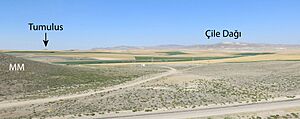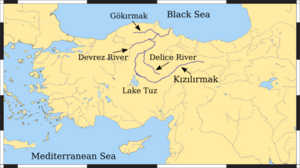Galatian War facts for kids
Quick facts for kids Galatian War |
|||||||
|---|---|---|---|---|---|---|---|
 A map showing the location of Galatia. |
|||||||
|
|||||||
| Belligerents | |||||||
|
Roman Republic Pergamum |
||||||
| Commanders and leaders | |||||||
| Eposognatus Orgiagon Chiomara Komboiomaros Gaulotos |
Gnaeus Manlius Vulso Attalus II |
||||||
| Strength | |||||||
| Over 50,000 men (overstated) | 30 - 35,000 Roman and allied forces 2,800 Pergamese troops |
||||||
| Casualties and losses | |||||||
| 40,000 dead or captured at Mount Olympus (overstated) 8000 dead at Ancyra Tolistobogii and Tectosagi massacred |
Unknown | ||||||
The Galatian War was a conflict that took place in 189 BC. It was fought between the Galatians, a group of Gauls who had settled in Asia Minor, and the powerful Roman Republic. The Romans were supported by their ally, the Kingdom of Pergamum. This war happened in Galatia, a region in central Asia Minor, which is now part of modern-day Turkey.
The Romans had recently defeated the Seleucids in a major war. They were busy finalizing a peace treaty. However, the Roman general, Gnaeus Manlius Vulso, decided to turn his attention to the Galatian tribes. These tribes had moved to Asia Minor about 100 years before this war. Vulso claimed the war was payback because the Galatians had helped the Seleucids during the recent conflict. Some ancient writers said Vulso started the war without permission from the Roman Senate, Rome's governing body. However, many modern historians believe the Senate secretly approved or at least allowed the campaign.
With help from Pergamum, the Roman army marched inland. They avoided cities controlled by the Seleucids to keep the peace treaty intact. Instead, they attacked cities not allied with the Seleucids. This strategy helped weaken potential enemies of Rome. The Romans then marched north and tried to negotiate with the Galatians, but it didn't work. The Romans defeated the Galatians in two main battles: one at Mount Olympus and another near Ancyra (modern-day Ankara).
These defeats forced the Galatians to ask for peace. The Romans returned to the coast of Asia Minor. There, Vulso finalized the Treaty of Apamea with the Seleucids. Lands that the Roman army marched through were given to Rome or its allies. Many historians believe this was one of the main goals of the campaign. When Vulso returned to Rome, he faced accusations of risking peace with the Seleucids. But he was cleared and given a triumph, a special parade to celebrate his victory. This war also brought new Greek and Asian customs and luxury items to Rome. Some ancient writers blamed these new influences for a decline in Roman morals. The wealth Vulso brought back was used to repay Roman taxpayers and fund new building projects.
Contents
Why the War Started
In 191 BC, Antiochus the Great, the ruler of the Seleucid Empire, invaded Greece. The Romans stepped in and defeated the Seleucids at the Battle of Thermopylae. This loss forced the Seleucids to retreat back to Asia Minor. The Romans followed them across the Aegean Sea. With their allies from Pergamum, they won a decisive victory at the Battle of Magnesia. After this, the Seleucids asked for peace. They began to work out a treaty with the Roman general Scipio Asiaticus.
Gnaeus Manlius Vulso became the new Roman consul (a top official) and arrived in Asia in 189 BC. He took command of Scipio's army, which was now idle after the Seleucid defeat. Vulso was supposed to finish the peace treaty. However, he wanted more glory. He told his soldiers he planned a new war against the Gauls of Galatia in Asia Minor. His reason was that the Galatians had sent soldiers to help the Seleucid army at the Battle of Magnesia. Many historians, following the ancient Roman writer Livy, believe Vulso mainly wanted to seize the Galatians' wealth and gain fame for himself. The Galatians had become rich by raiding their neighbors.
The Roman Senate had considered reducing the size of Vulso's army, but they decided against it. This suggests that the Senate knew a war with the Galatians was likely. They might have allowed the army to stay to balance the power of the Seleucids or to fill the power gap left by their defeat. Historian John D. Grainger estimates Vulso's army, including allies, had about 30,000 to 35,000 soldiers.
This war was unusual because it was the first time a Roman general started a war without the Senate's or the people's direct permission. This set a risky example for future generals. Vulso began preparing for war by asking the Pergamese for help. The King of Pergamum, Eumenes II, was in Rome. So, his brother, Attalus II, who was ruling in his place, led the Pergamese army. He joined the Roman army a few days later with 1,000 foot soldiers and 500 horsemen.
Marching Inland
The combined Roman and Pergamese army started their march from Ephesus. They moved inland, passing through cities like Magnesia and Alabanda. There, Attalus's brother, Athenaeus, joined them with more troops. They then marched to Antiochia, where Seleucus, Antiochus's son, offered them food supplies as part of the ongoing treaty. The army continued through the mountains of Caria, Phrygia, and Pisidia.
Historians note that Vulso avoided wealthier, fortified cities controlled by the Seleucids. Attacking these cities could have restarted the war with the Seleucids. Instead, Vulso chose routes through less wealthy areas. This suggests that his main goal was to weaken Seleucid allies, not just to loot.
The army entered the land of Cibyra, ruled by Moagetes. Moagetes paid Vulso a large sum of silver and promised to provide wheat. Vulso continued his march, crossing rivers and lakes. He helped the city of Sinda against Termessos, making Termessos pay a fee and leave Sindian territory.
Vulso marched for two more days, capturing the city of Cormasa and taking much treasure. He then accepted a payment of silver and grain from the city of Sagalassus. Historians estimate that Vulso collected a large amount of money and food during these marches. This reduced the resources that potential Seleucid allies could have used in a new war.
The consul reached the Rhotrine Springs, where Seleucus met him again. Seleucus took the injured Roman soldiers to Apamea and provided guides. Vulso continued to avoid Seleucid-controlled cities. The Romans found many cities on their route deserted. Some ancient writers said this was due to fear of the Romans. Others believe it was a Seleucid strategy to prevent small fights and protect the truce.
The Romans soon reached the border of the Tolistobogii, one of the three Galatian tribes. Vulso spoke to his troops about the upcoming war. He sent messengers to Eposognatus, a Tolistobogii chief who was friendly with Pergamum. Eposognatus was the only Galatian chief who had not allied with the Seleucids. The Galatian tribes were not united, and their chiefs often acted independently. Eposognatus asked the Romans not to invade his land and promised to try to make the other chiefs surrender.
The army marched deeper inland and camped near a Galatian stronghold called Cuballum. Here, Vulso captured what was likely a Galatian fort. The Galatian cavalry attacked the Roman advance guard, pushing them back and causing losses. But the Roman cavalry counter-attacked and drove the Galatians away. This Galatian attack might have been a scouting mission. Vulso then reached Abbassus, on the edge of Galatian lands, and began talks with Eposognatus. The army marched for five days through a treeless land called the Axylon. Vulso then crossed the Sangarius River, where priests from Pessinus met him and predicted his victory.
Battle at Mount Olympus
The next day, the Romans and Pergamese arrived at the city of Gordion, finding it empty. They destroyed it. While camping there, they received a message from Eposognatus. He reported that he had failed to convince the Galatians not to attack. The Galatians were gathering in the nearby mountains. The Tolistobogii and the Trocmi tribes, led by their chief Gaulotos, occupied Mount Olympus. The Tectosagi tribe went to another mountain. Mount Olympus is thought to be either Çile Dağı or Alis Daği. The Galatians had fortified Mount Olympus with a ditch and other defenses.
For the first two days, the Romans scouted the mountains. On their first patrol, the Galatian cavalry attacked them. The Galatians outnumbered the Roman cavalry and pushed them back to their camp. The Galatians had about 4,000 soldiers holding a hill overlooking the route to Mount Olympus.
On the third day, the Romans attacked the Galatian position. They used their light infantry from Thrace and Trallia. Roman archers, slingers, and javelin throwers caused heavy losses among the lightly armored Galatians. Those who tried to fight up close were defeated by the Romans' better weapons and armor. When the Roman legionaries finally stormed the Galatian camp, the defenders fled down the mountains. Many fell off cliffs or were killed by Roman-allied cavalry at the bottom. Ancient texts claim the Galatians lost 40,000 people dead or captured in this battle. However, even the Roman writer Livy, whose numbers are often exaggerated, doubted these figures.
Battle of Ancyra
After the Roman victory at Mount Olympus, the Tectosagi, led by their chief Komboiomaros, asked to meet Vulso. They wanted to meet halfway between their camp and Ancyra. Their main goal was to delay the Roman attack so their women and children could cross the Halys river to safety. They also planned to assassinate Vulso during the meeting. As the Romans headed to the conference, they saw about 1,000 Galatian cavalry charging at them. In the fight, the Galatians initially overwhelmed Vulso's small cavalry escort. But when 600 Roman cavalry, who were gathering supplies, arrived, they forced the Galatians to retreat.
The Romans spent the next two days scouting the area. On the third day, they met the main Galatian army, estimated to be between 50,000 and 60,000 men. Historians are doubtful of this high number. The Galatian cavalry was on the sides but fought like foot soldiers. The Romans started the battle again with their light infantry. The Galatians were attacked by long-range weapons. Their center broke quickly from the first charge of the Roman legions and fled to their camp. The sides of the Galatian army held out longer but were eventually forced to retreat. The Romans chased them and looted the Galatian camp. The surviving Galatians fled across the Halys river to join their women, children, and the Trocmi tribe. About 8,000 Galatians were killed, and many were captured. This battle was fought on Mount Magaba, thought to be Elmadağ, a hill near modern Ankara.
After the War
These two major military defeats forced the Galatians to ask for peace. This campaign made Vulso and his Roman legions very rich. The Galatians had collected great wealth from their many conquests in Asia Minor. The Galatians sent messengers to Vulso asking for peace. But because winter was coming, Vulso had returned to Ephesus. Vulso stayed in Asia Minor for another year. During this time, he finalized the Treaty of Apamea with Antiochus. He also divided the lands of the Asia Minor coast between Pergamum and Rhodes. When the Galatian messengers arrived, Vulso told them that King Eumenes II of Pergamum would give them the peace terms when he returned from Rome. The terms given to the Galatians were to stop their raids and stay within their own lands. However, they were not put under Roman or allied control; they remained free. Messengers from Greek cities in Asia Minor came to congratulate Vulso on his victory against the Gauls.
Chiomara was the wife of Orgiagon, a Galatian chief. She was captured by the Romans after the war. When she was returned to the Galatians for a ransom, she signaled to one of her tribesmen, who then killed the Roman soldier.
Vulso began his journey back to Rome in 188 BC and arrived in 187 BC. He traveled through Thrace, Macedonia, Thessaly, and Epirus. On his way back, he was attacked twice by Thracian thieves. A lot of treasure was stolen, and some of Vulso's men were killed.
When he returned to Rome, Vulso faced much criticism for starting the war without permission. However, he eventually overcame the opposition. The Senate awarded him a triumph. During the triumph, at least 52 Galatian chiefs were paraded in chains. All soldiers in the army received money from the war spoils. Officers received twice as much, and cavalrymen received three times as much. The wealth Vulso brought to Rome was used by the Roman Senate to pay off debts from the Second Punic War. Roman citizens also received payments.
The loot from this campaign was enormous. It included thousands of pounds of gold and silver, and many valuable coins. There was so much loot that all the Roman ships on the Anatolian coast couldn't carry it. Pergamum had to provide its fleet to carry the rest. As a result of the campaign and its wealth, Greek and Asian customs and luxury items began to be introduced to Rome. Livy and other ancient writers blamed these new influences for a decline in Roman morals. Livy noted that expensive furniture, tapestries, and musicians became common at dinner parties. Cooks also became highly valued.
Historian Philip Kay suggests that the loot brought by Vulso helped increase spending on Roman infrastructure. This included new ports and commercial buildings in Rome. It also funded the remodeling of Rome's sewer system, the construction and renovation of roads in Italy, and the building of large structures like the Basilica Porcia and the Pons Aemilius.
Images for kids





